Az oldal létrehozását egy egyedülállóan tehetséges zenész, egy kivételes ember ihlette. Ő Freddie Mercury. / The site was created by an uniquely talented musician, an exceptional person. He is Freddie Mercury.
Don't wanna be here? Send us removal request.
Photo

Boldog Nőnapot Kívánok minden kedves Hölgy Látogatónak! 😊🌹 * Happy Women's Day to all dear Lady Visitors! 😊🌹
18 notes
·
View notes
Photo

Freddie és Mary / Freddie and Mary ❤
Az 1970-es évek elején Freddie változatlanul Maryvel élt együtt közösen bérelt lakásukban. Az összes ismerősüknek, sőt Marynek is egy átlagos, heteroszexuális kapcsolatnak bizonyult az, ami köztük volt. Mary sokszor elkísérte Freddie-t a fellépéseikre és kénytelen volt végignézni, hogy a női rajongók állandóan körülötte hemzsegtek.
„Már akkor azt kezdtem érezni, hogy sztár lesz belőle. Már elindult az úton. Többé már nincs rám szüksége. Nem szöktek könnyek a szemembe, nem zaklatott fel a dolog. Örültem, hogy végre megtörténik, hiszen annyira tehetséges volt. Amikor lejött a színpadról, köré sereglett az összes lány. Teljesen lefoglalták. Már épp indultam volna, amikor utánam sietett. „Hát te meg hová mész?” – kérdezte, mire azt feleltem, hogy haza. Nem engedett. Aznap este rádöbbentem, hogy nekem is szerepet kell vállalnom ebben az egészben. Kezdett beindulni a dolog, és végignéztem, hogyan bontja ki a szárnyait. Csodálatos volt.” – emlékezett vissza Mary.
Freddie és Mary hamarosan találtak maguknak egy nagyobb lakást a Holland Road-on, amelyet 19 fontért béreltek. „Teljesen biztonságban éreztem magam mellette. Minél jobban megismertem, annál inkább önmagáért szerettem. Különleges ember volt, ritka az ilyen manapság. Egy dolog sosem változott, és ez a szeretet. Tudtuk, hogy megbízhatunk a másikban, és hogy biztonságban vagyunk egymás mellett. Sosem bántottuk volna egymást szándékosan.” – mesélte Mary. A beköltözésük után nem sokkal azonban valami megváltozott. Freddie titokban csalni kezdte a lányt.
**************************************************************************
In the early 1970s, Freddie continued to live with Mary in their rented flat. For all their acquaintances, and even for Mary, the average heterosexual relationship was what they were. Mary often accompanied Freddie to their shows and was forced to see that female fans were constantly around him.
“By then I was starting to feel like he was going to be a star. He was already on this road. He no longer need me. There were no tears in my eyes, it didn't bother me. I was glad it finally happened because he was so talented. When he came down the stage, all the girls were around him. They fully booked him. I would have just started but he hurrying after me. "Where are you going?" - he asked and I said, "Go home.". He wouldn't let me. That evening I realized that I too had to play a part in this. His career began to start and I watched he spread him wings. It was wonderful.” - Mary recalled.
Freddie and Mary soon found a larger flat on Holland Road, they rented for £ 19. “I felt completely safe with him. The more I got to know him, the more I loved himself. He was a special person, rare nowadays. One thing never changed, and that is love. We knew we could trust each other and that we were safe with each other. We would never have deliberately hurt one another.” - Mary said. However, soon after they moved in, something changed. Freddie started secretly cheating her.
[Irodalmak / References: 📚 - Lesley-Ann Jones (2011): Bohemian Rhapsody, The Definitive Biography of Freddie Mercury. - Matt Richards, Mark Langthorne (2019): Bohém Rapszódia.]
8 notes
·
View notes
Video
youtube
“1973. szeptember 13-án elkezdődött a „Queen I” turné, amikor a BBC Radio 1 készített a srácokkal egy élő koncertfelvételt az „In Concert” című sorozatuk számára, a Golders Green Hippodromeban.” 🎶
/
“On September 13, 1973, the "Queen I” tour began when BBC Radio 1 produced a live concert with the guys for their “In Concert” series at the Golders Green Hippodrome.” 🎶
#freddie mercury#freddiemercury#brianmay#rogertaylor#johndeacon#Queen#queenband#70s#london#uk#gig#earlyyears
8 notes
·
View notes
Photo








Szerencsétlenség Ausztráliában és az első "Top of the Pops" / Disaster in Australia and the first "Top of the Pops" 🎤🎥
A Queen 1974 elején meghívást kapott Ausztráliába, ahol a februári Sunbury Festival sztárvendégei lehettek. Ám az egész ausztráliai utazást és fellépést átok sújtotta. Brian az utazás miatt kapott oltásoktól fertőzésben szenvedett és már attól kellett félni, hogy levágják a karját üszkösödés miatt. Ahogy Brian felépült, a srácok már indultak is január 28-án Ausztráliába. Az ausztrál technikusok háborogtak, amiért a Queen hozta magával saját embereit és világítástechnikáját is. Ezután Brian betegeskedése mellé csatlakozott Freddie, akinek begyulladt a füle és a kapott gyógyszerektől kába volt, emellett pedig nem hallott rendesen. Ennek tetejében a fellépés közben a világítástechnika megadta magát, így hát nem volt meglepő, hogy az ausztrál sajtó másnap negatív kritikákon kívül mást, nem igazán fogalmazott meg a Queennel kapcsolatban. A fiúk lemondták a következő koncertet és visszautaztak Londonba.
A balszerencsék sorozata után 1974. február 18-án ismét a szerencse kopogtatott a Queen ajtaján, még pedig David Bowienak köszönhetően. Bowienak fellépése lett volt a BBC TV „Top of the Pops című műsorában, ám ezt sajnos le kellett mondania. A műsor producerének, Robin Nashnek azonnal keresnie kellett valakit Bowie helyett és felhívta az EMI reklámigazgatóját, Ronnie Fowlert. Ronnie nagyon szerette a Queent és az új albumon szereplő „Seven Seas of Rhye” című számot, így őket ajánlotta. Az 1970-es évek közepén a „Top of the Pops” akár 15 milliós nézettséggel is büszkélkedhetett és a Queen számára ez egy hatalmas és vissza nem térő lehetőségnek bizonyult. 1974. április 21-én tehát felléptek a műsorban. Az EMI kapott az alkalmon és két nappal később ki is adta a „Seven Seas of Rhye” kislemezt, és ezennel sikerült bekerülniük az Egyesült Királyság Top 10-es listájába.
**************************************************************************
The Queen was invited to Australia in early 1974 to attend the February Sunbury Festival. But all of Australia's travel and acting was cursed. Brian was infected with the vaccines he had received for the trip and had to fear cutting his arm for gangrene. By the time Brian recovered, the guys had already left for Australia on January 28th. Australian technicians were outraged at the Queen bringing their own people and lighting equipment. Then, along with Brian's illness, Freddie joined him, who had inflamed ears and was fed up with the medication he was dizzy, and he didn't hear properly. On top of that, lighting technology surrendered during the show, so it was no surprise that the Australian press did not really say anything about Queens the next day, apart from negative criticism. The boys canceled their next concert and returned to London.
After a series of bad luck, on February 18, 1974, luck knocked on the Queen's door again thanks to David Bowie. Bowie appeared on BBC TV's "Top of the Pops", but unfortunately had to resign. The show's producer, Robin Nash, immediately had to find someone to replace Bowie and called EMI advertising director Ronnie Fowler. Ronnie was very fond of Queens and the song "Seven Seas of Rhye" on the new album, and he recommended them. In the mid-1970s, "Top of the Pops" boasted up to 15 million views and proved to be a huge and irreversible opportunity for the Queen. So on April 21, 1974, they appeared on the show. EMI got the chance and two days later released the single "Seven Seas of Rhye" and they are now in the UK's Top 10 list.
[Irodalmak / References: 📚 - David Bret (1996): Borotvaélen, Freddie Mercury története. - Lesley-Ann Jones (2011): Bohemian Rhapsody, The Definitive Biography of Freddie Mercury. - Matt Richards, Mark Langthorne (2019): Bohém Rapszódia.]
#freddie mercury#freddiemercury#brianmay#rogertaylor#johndeacon#Queen#queenband#australia#70s#london#topofthepops#sevenseasofrhye
7 notes
·
View notes
Photo

Minden kedves Látogatómnak Nagyon Boldog és Sikerekben Gazdag Új Évet kívánok és persze azt, hogy a jövő év egyetlen napja se teljen el Freddie nélkül! 😊🍾🎆🍀👑 * I wish a Very Happy and Successful New Year to all of my dear Visitors and of course that no day will pass without Freddie in the new year! 😊🍾🎆🍀👑
3 notes
·
View notes
Photo


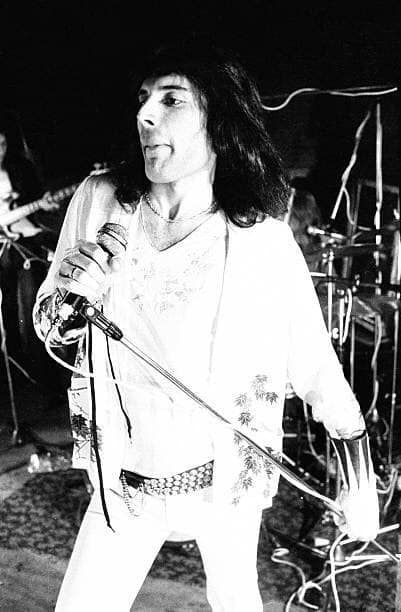

1973.07.13. - Anglia, Basingstoke: Queen Mary College 🎤
13/07/1973 - England, Basingstoke: Queen Mary College 🎤
79 notes
·
View notes
Photo










1973.07.13. - Anglia, Basingstoke: Queen Mary College 🎤
13/07/1973 - England, Basingstoke: Queen Mary College 🎤
18 notes
·
View notes
Photo










1973.07.13. - Anglia, Basingstoke: Queen Mary College 🎤
13/07/1973 - England, Basingstoke: Queen Mary College 🎤
12 notes
·
View notes
Photo






“Queen I” turné / “Queen I” tour 🎤
6 notes
·
View notes
Photo
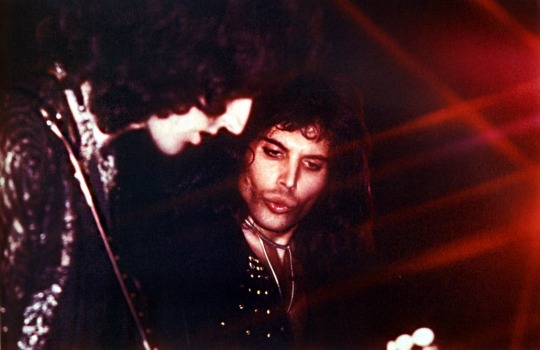
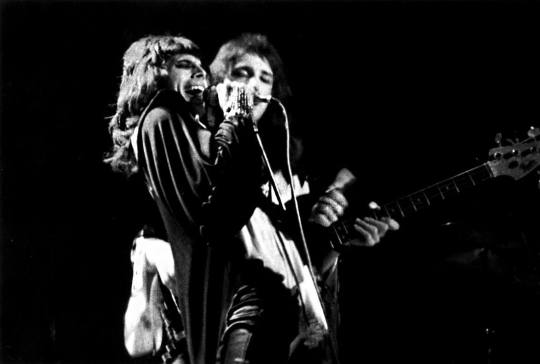
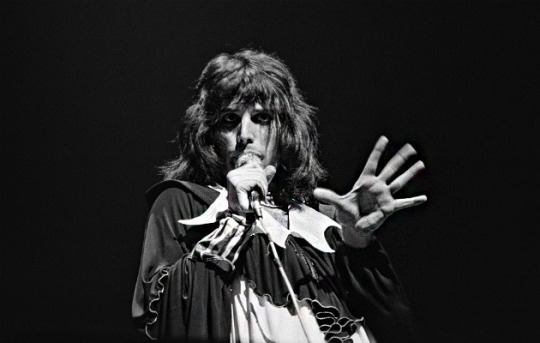
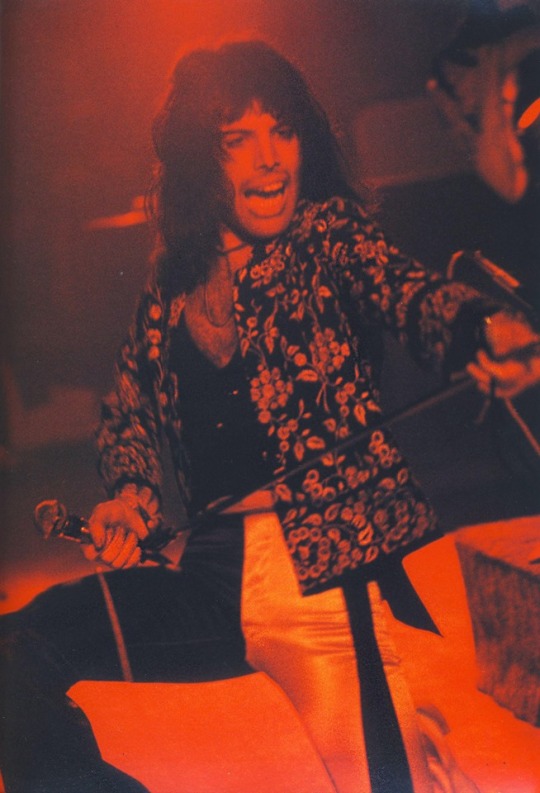
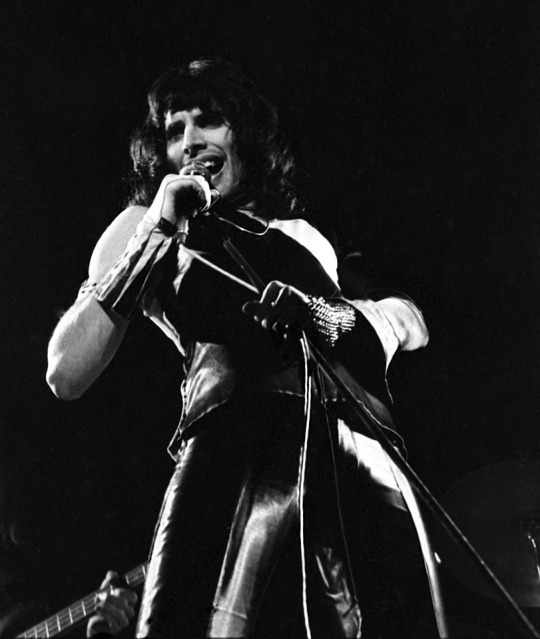
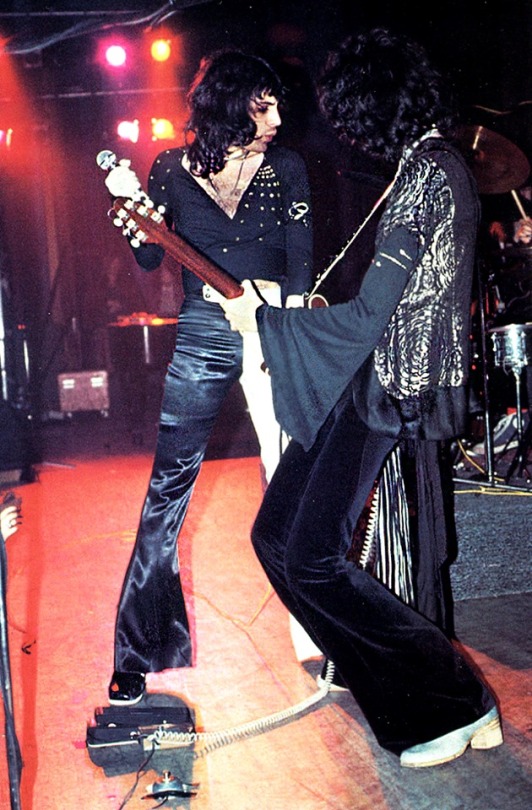
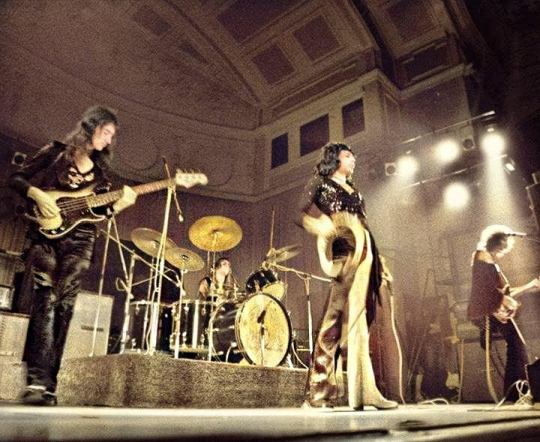
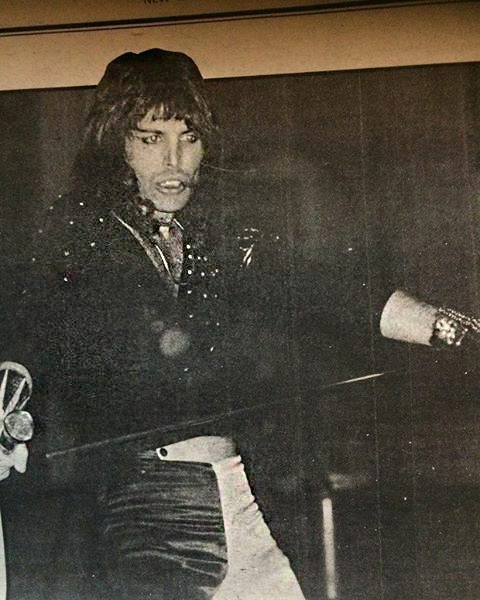

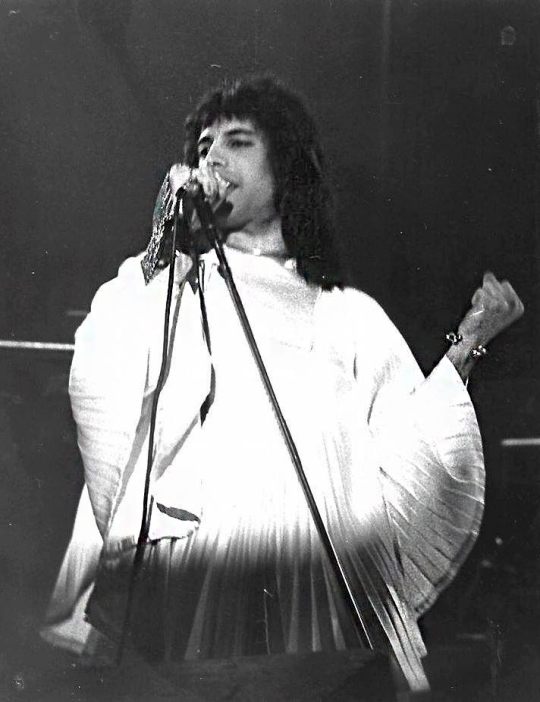
"Queen I" turné / "Queen I” tour 🎤
1973. szeptember 13-án elkezdődött a „Queen I” turné, amikor a BBC Radio 1 készített a srácokkal egy élő koncertfelvételt az „In Concert” című sorozatuk számára, a Golders Green Hippodromeban. Sikerült eljutniuk Németországba és Luxembourgba is, ezek voltak a Queen első külföldi szereplései. Ezután visszatértek Londonba, ahol hatalmas sikert arattak a Paris Theatreben, majd két koncertet adtak az Imperial Collegeban is, ahol november 2-án lezajlott az első teltházas koncertjük. Rosemary Horide az alábbi kritikát írta meg a koncert után: „A frontember, Freddie Mercury fel-alá járkált a kis színpadon, egyszerre volt heves és érzéki, ahogyan a mikrofont lengette, miközben első albumuk dalai szóltak. Ha a Queen ilyen jó formában lesz a Mott The Hoople-turnén is, akkor jobb, ha a Mott résen lesz. Lehet, hogy a Queen több lesz ott, mint egyszerű elő zenekar.”
A Mott The Hoople együttes elő zenekaraként 1973. november 12-én indultak útnak. A 24 állomásos turnét Leedsben, a Town Hallban kezdték el, ahol előadtak pár dalt az első albumról, kipróbálták, hogy hogyan reagál a közönség a második lemez egyes számaira, majd bedobtak néhány biztos sikert is, mint például a „Big Spender”-t. Freddie eközben a legbotrányosabb formáját hozta. A zenei sajtóban számos negatív kritika jelent meg erről a koncertről, azonban ezek a kritikák a zenével nem törődtek, csak azzal, hogy sértő, személyeskedő megjegyzéseket tegyenek az előadókra. Az együttes tagjai azonban úgy voltak vele, hogy „jobb, ha lenéznek, mintha átnéznek rajtunk”.
1973. december 3-án a Queen tagjai részt vettek második rádiófelvételükön a BBC „Sound of the Seventies” műsorában, ahol a „Great King Rat”, a „Son and Daughter”, a „Modern Times Rock ’N’ Roll” és az „Ogre Battle” című szerzeményeiket vették fel. Decemberben a Queen két további koncertet adott a híres londoni Hammersmith Odeonban.
**************************************************************************
On September 13, 1973, the "Queen I" tour began when BBC Radio 1 produced a live concert with the guys for their "In Concert" series at the Golders Green Hippodrome. They managed to get to Germany and Luxembourg, both of which were Queen's first foreign appearances. Then they returned to London, where they had huge success at the Paris Theatre, and then gave two concerts at Imperial College, where their first full house concert took place on November 2. Rosemary Horide wrote the following criticism after the concert: “Frontman Freddie Mercury was walking up and down on the small stage, at the same time intense and sensual as he swayed the microphone while singing songs from their first album. If the Queen is in such good shape on the Mott The Hoople tour, then it is better to be on the Mott slot. Maybe the Queen will be there more than just an pre-band.”
The band premiered on November 12, 1973 as a pre-band for Mott The Hoople. The 24-stop tour began at Town Hall in Leeds, where they performed a few songs from the first album, tested how the audience reacted to the tracks on the second album, and then tossed in some winning hits like "Big Spender." Freddie was in the most scandalous form on this concert. There were many negative criticisms of this concert in the music press, but these criticisms were not about music, only about making offensive, personal comments on the performers. However, the band members said that "it is better to look down than doesn’t take into account".
On December 3, 1973, members of the Queen attended their second radio show on the BBC's "Sound of the Seventies," featuring "Great King Rat," "Son and Daughter," "Modern Times Rock 'N' Roll" and they recorded "Ogre Battle". In December, the Queen gave two more concerts at the famous Hammersmith Odeon in London.
[Irodalmak / References: 📚 - David Bret (1996): Borotvaélen, Freddie Mercury története. - Lesley-Ann Jones (2011): Bohemian Rhapsody, The Definitive Biography of Freddie Mercury. - Matt Richards, Mark Langthorne (2019): Bohém Rapszódia.]
#freddiemercury#freddie mercury#brianmay#rogertaylor#johndeacon#Queen#queenband#70s#1973#bbc#germany#luxembourg#mott the hoople#bigspender#greatkingrat#sonanddaughter#moderntimesrocknroll#ogrebattle#london#hammersmithodeon
11 notes
·
View notes
Video
youtube
Érdekesség / Curiosity ⭐
"A Trident stúdiójában történő munkák alatt, Freddiet bemutatták Robin Cable producernek. Cable rávette Freddiet, hogy készítse el a Beach Boys "I Can Hear Music" című szám feldolgozását. Freddie felnénekelte a dalt, majd később Brian és Roger is csatlakoztak gitárral és dobbal. Ezután Freddie egyedül elkészítette a "Goin' Back" című, régi Dusty Springfield számot is. 1973-ban az EMI meggyőzte Cablet, hogy adják ki a felvételt kislemezen, azonban a Queen nevet nem használhatták. A két dal megjelenése a Larry Lurex álnéven került a nagyközönség elé." 🎶
/
"During their work at Trident's studio, Freddie was introduced to Robin Cable as a producer. Cable convinced Freddie to produce the Beach Boys song "I Can Hear Music." Freddie then produced the old Dusty Springfield song, "Goin 'Back". In 1973, EMI convinced Cablet to release the album, but they couldn't use the name of "Queen". The two songs appeared under the pseudonym Larry Lurex to the general public." 🎶
[Irodalmak / References: 📚 - Matt Richards, Mark Langthorne (2019): Bohém Rapszódia.]
1 note
·
View note
Photo

A második nagylemez: "Queen II" / The second album: "Queen II" 📀
1973 augusztusában a Queen visszatért a stúdióba és elkezdték a második nagylemezük munkálatait. Az együttes tagjai továbbra is a tökéletességre törekedtek és nagyon vágytak már egy igazi slágerre. A Trident ezúttal saját stúdiót biztosított a fiúk számára, ahol a saját tempójukban végezhették a munkát. A második album a „Queen II” címet kapta, melyen tizenegy dal kapott helyet, ebből hatot Freddie írt. A Freddie által írt dalok a lemez második oldalán, vagy ahogy ők nevezték a „The Black Side”, azaz a fekete oldalon foglaltak helyet. Ugyanis a Queen tagjai nem a hagyományos 1-es és 2-es oldal, hanem a „fehér oldal” és a „fekete oldal” elnevezést használták, és a dalok hangulata is ezekhez az elnevezésekhez illeszkedett. A fehér oldalon az érzelmesebb számok, míg a fekete oldalon a sötétebb és különc szerzemények szerepeltek. A Queen első slágere a „Seven Seas of Rhye” című dal lett, mely Freddie keze munkáját dicséri.
„A Queen II a zenekar kísérletező kedvének köszönhetően igazi zenei csemege. Minduntalan fel-felbukkan egy újabb oda nem illő hang. Egyszerre rejtelmes és ugyanakkor operaszerű, tele virtuozitással, ami folyamatosan azt mutatja, milyen kirobbanóan tehetségesek a szerzők.” – írta Daniel Ross a Queen második nagylemezéről. Freddie dalai a legkülönbözőbb zenei stílusokat ölelik fel, a keményebb „Ogre Battle”-től kezdve a középkori történetet mesélő „The Fairy Feller’s Master-Stroke”-ig. A „The March of the Black Queen” című szerzeménye olyan összetettre sikerült, hogy élőben sosem játszották el.
A kemény stúdiómunka mellett azonban megint csak nem jutott idő a koncertezésre. Ez idáig csupán négy fellépésük volt 1973-ban és az előző évben is összesen csak öt koncertet adtak. Aggódni kezdtek, hogy a Queen elveszíti a koncerteken összegyűjtött rajongókat, így a Trident elkezdte szerezni a srácok első igazi turnéját.
**************************************************************************
In August 1973, the Queen returned to the studio and began work on their second album. The members of the band continued to strive for perfection and longed for a real hit. This time Trident provided a studio for the boys to work at their own pace. The second album, entitled "Queen II", featured eleven songs, six of which were written by Freddie. The songs written by Freddie were on the back of the album, or as they called it "The Black Side". The members of the Queen used the names "white side" and "black side" instead of the traditional page 1 and 2, and the mood of the songs matched these names. The white side featured more emotional songs, while the black side featured darker and eccentric compositions. The Queen's first hit was "Seven Seas of Rhye," which praises Freddie's work.
“Queen II is a real musical delicacy thanks to the band's experimentation. Another inappropriate voice pops up every time. At the same time, it's mysterious and yet opera-like, full of virtuosity, which constantly shows how explosively talented the authors are." - wrote Daniel Ross on Queen's second album. Freddie's songs span a variety of musical styles, from the tougher "Ogre Battle" to the medieval storyline "The Fairy Feller's Master-Stroke." The song "The March of the Black Queen" was so complex that it was never played live.
But with hard studio work, there was no time for the concerts. So far, they have had only four shows in 1973 and the previous year they have only given five concerts. Concerned that the Queen was losing fans at the concerts, so Trident was starting to get the guys on their first real tour.
[Irodalmak / References: 📚 - David Bret (1996): Borotvaélen, Freddie Mercury története. - Lesley-Ann Jones (2011): Bohemian Rhapsody, The Definitive Biography of Freddie Mercury. - Matt Richards, Mark Langthorne (2019): Bohém Rapszódia.]
#freddiemercury#brianmay#rogertaylor#johndeacon#Queen#queenband#queenii#secondalbum#70s#1973#theblackside#seven seas of rhye#tridentstudios
1 note
·
View note
Video
youtube
A "Queen" népszerűsítése / Promotion of the "Queen" 🎥
A Trident 1973 nyarának végére, 62 ezer fontot költött a Queenre, azonban ennek csak a töredékét látták viszont. A megjelent kislemez bukás volt, az első nagylemezük pedig 8 hónapig elkerülte a legfontosabb toplistákat, és amikor fel is került, akkor is csak a 37. helyig jutott. Annak érdekében, hogy több hírnevet szerezzenek az együttesnek, a Trident felfogadta Tony Brainsbyt, aki reklámszakemberként dolgozott. Brainsby nagyon jó kapcsolatot ápolt a zenekar tagjaival, leginkább Freddievel.
„Természetesen Freddie volt a legfeltűnőbb. Alig hittem a szememnek. Vörös bársonyból készült, testhezálló nadrágot viselt, a körmét feketére pingálta, a haja hosszú volt, meg persze kiállt a foga. Azonnal ugrott bármiféle megjegyzésre a fogával kapcsolatban. Erős akaratú volt, szemmel láthatóan ambiciózus, ugyanakkor elbűvölő is. Szerintem ő jelentette a kurázsit a bandában. Minden második mondathoz hozzáfűzte, hogy drágáim vagy édeseim, igazán szórakoztató és bájos volt. Szuper társaság volt. Egy pillanatra sem unatkozott mellette az ember. A lányok imádták, amikor bejött az irodába. Akkoriban persze Maryvel élt. Mindenki számára teljesen homályba borult a szexuális élete, igazából sosem értettük. Ő egyetlen alkalommal sem kommentálta.” – mesélte Brainsby.
1973-ban az együttes tagjai egy rövidfilm elkészítéséhez is hozzákezdtek annak érdekében, hogy népszerűsítsék az új albumukat Európában és Amerikában egyaránt. A rendező Mike Mansfield volt, aki arra kérte Freddiet, hogy találjon ki valami eladhatót. Freddie szokásához híven bedobta magát és leborotválta a mellkasát. A kisfilm készítése kellemetlen volt a srácok számára, hiszen azelőtt sosem játszottak playbacket és nagyon idegesítette őket, hogy amikor a „Liar” tempója felgyorsult, nehezen tudtak vele lépést tartani. Miután a rendező brigád és a Queen tagjai is teljesen kiborultak, a fiúk elküldték Mainsfieldet. A filmet tehát ezután úgy rendezték, ahogy nekik tetszett.
**************************************************************************
By the end of the summer of 1973, Trident had spent £ 62,000 on the Queen, but only a fraction of that was seen. The single was a failed, and their album avoided the top charts for 8 months, and when it did, it only finished 37th. In order to gain more fame for the band, Trident hired Tony Brainsby to work as an advertising professional. Brainsby had a very good relationship with the band members, most notably Freddie.
“Of course, Freddie was the most striking. I could hardly believe my eyes. He wore red velvet tight-fitting trousers, pinged his nails black, long hair, and, of course, his teeth protruding. He immediately jumped to any comment on his tooth. He was strong-willed, apparently ambitious but also charming. I think he meant the gut in the band. He added to every second sentence that my dears or sweethearts were really fun and charming. He was a very good companionship. You couldn’t be bored with him for a second. The girls loved it when he came into the office. Of course he was living with Mary at the time. His sex life was completely obscure, we never really understood. He never commented. ” - Brainsby said.
In 1973, the band also began producing a short film to promote their new album in Europe and America. The director was Mike Mansfield, who asked Freddie to come up with something for sale. Freddie, as usual, threw himself in and shaved his chest. Making the short film was a nuisance for the guys as they had never played a playback before and were very upset that it was difficult to keep up with the pace of "Liar". After both the Brigade and the Queen were completely upset, the boys sent Mainsfield. So the movie was then directed as they liked.
[Irodalmak / References: 📚 - David Bret (1996): Borotvaélen, Freddie Mercury története. - Lesley-Ann Jones (2011): Bohemian Rhapsody, The Definitive Biography of Freddie Mercury. - Matt Richards, Mark Langthorne (2019): Bohém Rapszódia.]
#freddiemercury#brianmay#rogertaylor#johndeacon#Queen#queenband#Liar#keepyourselfalive#70s#tridentstudios
1 note
·
View note
Photo

Az első nagy lemez: "Queen" / The first album: "Queen" 💿
Az együttes első nagylemeze a „Queen” címet kapta, mely 1973. július 13-án jelent meg. A lemez borítóján található fotót, Roger egyik barátja készítette, aki elkísérte a bandát a cornwalli turnéjára. A fotón Freddie látható kinyújtott karral, mikrofonállvánnyal a kezében, alakját pedig hátulról két reflektor világítja meg. Az első kislemezhez hasonlóan, ez az album is vegyes fogadtatásban részesült. A Rolling Stone magazin a következő nyilatkozatot tette: „Ebben a dallamos, energikus angol négyesben határozottan megvan minden, hogy elragadják a Zeptől a heavy metal trónt, és hatással legyenek a rock világra. Csodás album.”. Ezzel ellentétben a New Musical Express szerint egy „vödörnyi húgy” lett a lemez. Az eladások nem úgy alakultak, ahogy azt a srácok remélték.
Nem sokkal később azonban a Queennek ismét szerencsésen alakult a helyzete. A lemezük egy jelöletlen, felirat nélküli példánya, egy befolyásos tévés producer, Mike Appleton asztalán kötött ki. Appleton felelt a BBC egyik zenei műsoráért, a The Old Grey Whistle Testért. A producer meghallgatta a lemez első dalát, a „Keep Yourself Alive”-ot, amit nagyon szeretett volna lejátszani a műsorában, ám fogalma sem volt róla, hogy kié a dal. A dal kísérőzenéje lett Franklin D. Roosevelt amerikai elnök 1930-as évekbeli elnöki kampányának filmkockáihoz, melyet 1973. július 24-én adtak le a műsorban. Másnap a BBC rengeteg pozitív telefonhívást kapott, azonban a Trident és az EMI munkatársai rettentő idegesek lettek. A Queen számára azonban jó reklámnak bizonyult ez a véletlen. Másnap már meg is kellett jelenniük a BBC-ben, hogy négy számukat felvegyék a BBC, The John Peel Show műsora számára. A kislemez két dala mellé a „Liar”-t és a „See What a Fool I’ve Been”-t rögzítették.
**************************************************************************
The band's first album, "Queen," was released on July 13, 1973. The photo on the album cover was taken by a friend of Roger's, who accompanied the band to the Cornwall tour. The photo shows Freddie with an outstretched arm, a microphone stand in his hand and two reflectors illuminating his shape from behind. Like the first single, this album received mixed acclaim. Rolling Stone magazine made the following statement: “In this melodic, energetic English four, there is definitely something to take from the Zep to the heavy metal throne and impact the rock world. It's a wonderful album." In contrast, according to New Musical Express, the album became a "bucket of piss". Sales didn't turn out the way the guys hoped.
Shortly thereafter, however, Queen again found itself fortunate. An unmarked, untitled copy of their album landed on the table of an influential TV producer, Mike Appleton. Appleton was responsible for one of the BBC's music shows, The Old Grey Whistle Test. The producer listened to the album's first song, "Keep Yourself Alive," which he wanted to play in his show, but had no idea who the song was. The song became the accompaniment to the movie frames of Franklin D. Roosevelt's presidential campaign in the 1930s, released on July 24, 1973. The next day, the BBC received a lot of positive phone calls, but Trident and EMI staff were terribly nervous. For the Queen, however, this was a good advertisement. They had to appear on BBC the next day to record four songs of them for the BBC, The John Peel Show. Beside the two songs, they were recorded the "Liar" and "See What a Fool I’ve Been".
[Irodalmak / References: 📚 - David Bret (1996): Borotvaélen, Freddie Mercury története. - Lesley-Ann Jones (2011): Bohemian Rhapsody, The Definitive Biography of Freddie Mercury. - Matt Richards, Mark Langthorne (2019): Bohém Rapszódia.]
#freddiemercury#brianmay#rogertaylor#johndeacon#queen#queenband#70s#1973#bbc#keepyourselfalive#tridentstudios#emi#liar#seewhatafoolivebeen#johnpeel#show
1 note
·
View note
Video
youtube
“Great King Rat” demofelvétel a De Lane Lea stúdióból / “Great King Rat” demo recording from De Lane Lea Studio 🎶
#freddiemercury#brianmay#rogertaylor#johndeacon#queen#queenband#greatkingrat#demo#studioworks#earlyyears#delanelea#70s#1971
0 notes
Photo

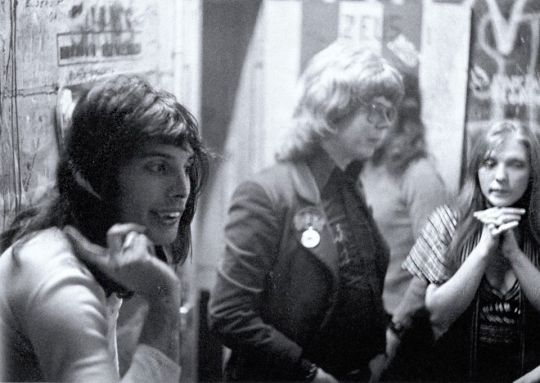
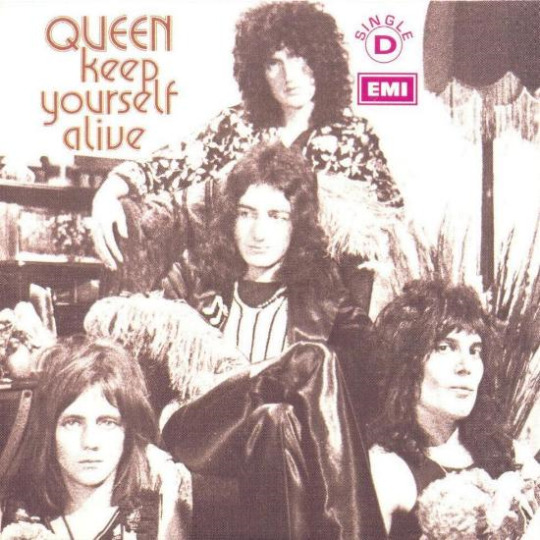
Újabb szerződéskötés: EMI és Elektra / New contracting: EMI and Elektra
1973-ban a Queenre végre rámosolygott a szerencse. Ronnie Beck, a Trident egyik munkatársa elvitte a Queen demóját a cannesi MIDEM fesztiválra, ahol az EMI egyik képviselője, Roy Featherstone meghallgatta azt. Featherstone azonnal felvette a kapcsolatot a Trident munkatársaival és találkozni akart az együttessel. Mindeközben, a Queent meghívták a Radio One egyik műsorába, ahol ugyan fizetséget nem kaptak, de hatalmas lehetőség volt számukra. 1973. február 5-én négy számot vettek fel a Maida Vale stúdióban, a „My Fairy King”-et, a „Keep Yourself Alive”-ot, a „Liar”-t és a „Doing Alright”-ot, melyet tíz nappal később le is adtak.
1973 márciusában az EMI, az a cég, aki egyébként az előző évben elutasította a Queent, végre szerződést ajánlott nekik a felvételeik nagy-britanniai és európai terjesztésére. A Queen április 9-én konceretet adott a The Marqueeban, melynek az volt a célja, hogy lenyűgözzék Jack Holsent, az amerikai Elektra egyik képviselőjét. Holsent azonnal meggyőzték, így a terjesztés az Amerikai Egyesült Államokban is elkezdődhetett. Freddie hangja mindenkit lenyűgözött. „Szokatlanul széles tartományban énekelt, s néhány taktus alatt képes volt a mély, fátyolos rockmorgásból finom, reszketeg tenorba váltani, majd továbbemelkedni, míg el nem érte a koloratúrszoprán magasságot, s még itt is kristálytiszta tudott maradni”.
A Queen első hivatalos kislemezén Brian két száma, a „Keep Yourself Alive” és a „Son and Daughter” kapott helyet, melyet 1973. július 6-án jelentetett meg az EMI. A lemez vegyes fogadtatásban részesült és nem igazán foglalkoztak vele, így Nagy-Britanniában és az Egyesült Államokban is megbukott. A rossz kritikák oka az volt, hogy a Queen zenéje meglehetősen különbözött az akkor a toplistákon futó, megszokott tucat számoktól. A katasztrofális debütálás után tehát fontossá vált, hogy az első nagylemez sikeres legyen.
**************************************************************************
In 1973, the Queen was finally lucky. The Trident’s colleague, Ronnie Beck took the Queen's demo to the Cannes MIDEM Festival, where Roy Featherstone, an EMI representative, listened it. Featherstone immediately contacted Trident and wanted to meet with the band. Meanwhile, Queen was invited to a show on Radio One, where they didn't get paid, but it was a huge opportunity for them. On February 5, 1973, four tracks were recorded at Maida Vale studio, "My Fairy King," "Keep Yourself Alive," "Liar," and "Doing Alright" and ten days later they played it.
In March 1973, EMI, the company that had rejected Queens the previous year, finally offered them a contract to distribute their recordings in the UK and Europe. On April 9, the Queen gave a concert at The Marquee to impress Jack Holsen, an American Elektra representative. Holsen was immediately persuaded so dissemination could begin in the United States. Freddie's voice fascinated everyone. "He sang in an unusually wide range, and in a few strokes he was able to change from deep rock to delicate, shaky tenor, then advanced until he reached the height of the coloratura soprano, and he still remained crystal clear."
The Queen's first official single, Brian's two tracks, "Keep Yourself Alive" and "Son and Daughter," were released on July 6, 1973 by EMI. The album received mixed acclaim and didn't really care about it, so it failed in Britain and the United States. The reason for the bad criticism was that the Queen's music was quite different from the usual dozens of songs on the charts at the time. So after the catastrophic debut, it became important for the first album to be successful.
[Irodalmak / References: 📚 - David Bret (1996): Borotvaélen, Freddie Mercury története. - Lesley-Ann Jones (2011): Bohemian Rhapsody, The Definitive Biography of Freddie Mercury. - Matt Richards, Mark Langthorne (2019): Bohém Rapszódia.]
#freddiemercury#brianmay#rogertaylor#johndeacon#queen#queenband#emi#elektra#70s#1973#keepyourselfalive#liar#doinalright#tridentstudios#ronniebeck#radioone#myfairyking
0 notes
Video
youtube
“Jesus” demofelvétel a De Lane Lea stúdióból / “Jesus” demo recording from De Lane Lea Studio 🎶
#freddiemercury#brianmay#rogertaylor#johndeacon#queen#queenband#jesus#demo#studioworks#earlyyears#70s#delanelea
0 notes